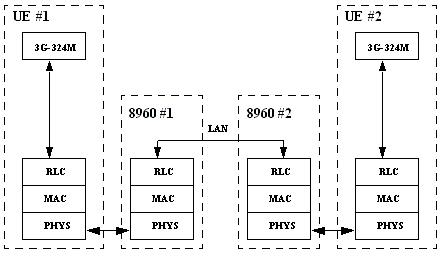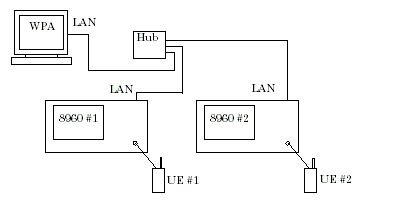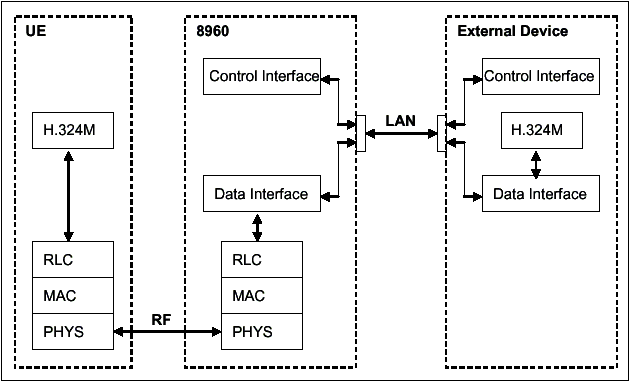Video Call
Video Call Type
This section is only applicable to the lab application.
In the lab application only, the
Synchronous/Transparent CS Data Service
supports three types of video calls,
UE-to-UE
video calls,
UE-to-8960LAN
video calls, and
Loopback
video calls. A test application with the required feature license supports only UE-to-UE video calls.
When the test set receives a request from the UE for a video call connection, the
Video Call Type
setting determines whether the test set attempts to set up the connection as a
UE-to-UE
video call (the test set must have an
External Device Connection
with another test set for this to succeed), a
UE-to-8960LAN
video call, or a
Loopback
video call.
GPIB command: CALL:VIDeo:TYPE
UE-to-UE Video Call
This section is only applicable to the lab application and to a test application with the required feature license.
The Synchronous/Transparent CS Data Service can be used to make an 3G-324M (derived from H.324M) UE-to-UE video call. Before making a UE-to-UE video call, you must first establish an External Device Connection between two 8960s. The external device connection allows the two 8960s to coordinate the setup and release of the CS data service and exchange the traffic plane data being sent by the UEs. This configuration allows the 3G-324M layers in the two UEs to communicate as they would in a real network to provide a video call service.
Once you have established an external device connection between the two 8960s and have camped the UEs to the 8960s, you can originate a UE-to-UE video call from one of the UEs, and answer the call on the other. The 8960 connected to the originating UE commands the other 8960 to set up a CS data synchronous/transparent call to its UE. Once the call has been connected (the UE has responded to the page and you've answered the call), the call setup is completed to the originating UE and 3G-324M traffic data begins to flow (see UE-Initiated UE-to-UE Video Call Origination Ladder Diagram ladder diagram). You can release the UE-to-UE video call from either of the UEs (see UE-Initiated UE-to-UE Video Call Release Ladder Diagram ladder diagram), or from either of the 8960s (see Test Set-Initiated UE-to-UE Video Call Release Ladder Diagram ladder diagram).
For the lab application only, the number dialed into the UE originating the call is displayed in the
UE Information
area under
Called Party Number
, and if
Calling Party Number Inclusion
is set to
Include
, the
Calling Party Number
is displayed on the screen of the UE receiving the call (see
Calling Party Number Parameters
). Once a UE-to-UE video call is established, the
Current Service Type
becomes CS Data - UE to UE Video Call.
While on a UE-to-UE video call, you can perform many transmitter measurements on the UEs. For the lab application only, you can also monitor the over-the-air messaging between the 8960s and UEs using the Wireless Protocol Advisor's (WPA) Protocol Logging functionality. The WPA will not capture the proprietary messages sent between the two 8960s, nor will it decode the 3G-324M application layer messages from the UEs.
Other Considerations
The 8960 receiving the UE-to-UE video call origination must be in
Active Cell Operating Mode
, in
Idle
state.
If one of the 8960s is partially preset while up on a UE-to-UE video call, the call to its UE is dropped with no over-the-air signaling. If the other UE does not recognize that the call has dropped (and thus ends the call), you should manually end the call or partially preset its 8960 as well.
If one of the 8960s is fully preset while up on a UE-to-UE video call, the external device connection is disconnected, which causes both 8960s to end the call with their respective UEs.
UE-to-8960LAN Video Call
This section is only applicable to the lab application.
The
UE-to-8960LAN
video call feature is used to establish a 3G-324M (derived from H.324M) video call between a UE and an external device via the test set's
LAN 2 PORT
. The test set processes the signalling required to establish a
Synchronous/Transparent CS Data Service
bearer. The UE and external device then exchange signalling and 3G-324M data over this bearer.
The UE-to-8960LAN feature includes two interfaces: the control interface and the data interface.
The control interface sends and receives control messages to and from the external device. The following messages can be sent between the test set and external device control interfaces:
Establish Video Call Request
You can originate a
UE-to-8960LAN
video call from your UE (see
UE-Initiated UE-to-8960LAN Video Call Origination Ladder Diagram
). You can also originate a
UE-to-8960LAN
video call from your external device by sending an "Establish Video Call Request", which is formatted as follows:

The test set then pages the UE and establishes the CS data bearer. See External Device-Initiated UE-to-8960LAN Video Call Origination Ladder Diagram .
Allow Remote Call Origination State
must be set to
On
to originate a
UE-to-8960LAN
video call from your external device.
Terminate Video Call Request
You can release the
UE-to-8960LAN
video call from your UE (see
UE-Initiated UE-to-8960LAN Video Call Release Ladder Diagram
) and from the test set (by selecting
End Call
(
F3
), see
Test Set-Initiated UE-to-8960LAN Video Call Release Ladder Diagram
). You can also release the
UE-to-8960LAN
video call from your external device by sending a "Terminate Video Call Request", which is formatted as follows:

The test set then sends a Disconnect message to the UE and releases the CS data bearer. See External Device-Initiated UE-to-8960LAN Video Call Release Ladder Diagram .
Allow Remote Call Release State
must be set to
On
to release the
UE-to-8960LAN
video call from your external device.
Video Call Established Indication
If you set
Sending of Call Status Indication State
to
On
, after the CS data bearer is established (call status changes to
Connected
), the test set will send a "Video Call Established Indication" to the external device, which is formatted as follows:

See UE-Initiated UE-to-8960LAN Video Call Origination Ladder Diagram and External Device-Initiated UE-to-8960LAN Video Call Origination Ladder Diagram . Note that the timing between the "Video Call Established Indication" and the arrival of the first data message on the data interface is not specified; either message can arrive at the external device first.
Video Call Terminated Indication
If you set
Sending of Call Status Indication State
to
On
, after the CS data bearer is released (call status changes to
Idle
), the test set will send a "Video Call Terminated Indication" to the external device, which is formatted as follows:

See UE-Initiated UE-to-8960LAN Video Call Release Ladder Diagram , Test Set-Initiated UE-to-8960LAN Video Call Release Ladder Diagram and External Device-Initiated UE-to-8960LAN Video Call Release Ladder Diagram . Note that the timing between the "Video Call Terminated Indication" and the arrival of the last data message on the data interface is not specified; either message can arrive at the external device last.
UE-to-8960LAN Control Parameters
-
Allow Remote Call Origination State
Allow Remote Call Origination State must be set to
Onbefore you can originate aUE-to-8960LANvideo call from your external device (using an Establish Video Call Request ). IfAllow Remote Call Origination Stateis set toOff, if the external device sends an "Establish Video Call Request", an error is posted by the test set.GPIB command: CALL:VIDeo:LAN:CONTrol:RCORiginate[:STATe]
-
Allow Remote Call Release State
Allow Remote Call Release Statemust be set toOnbefore you can release theUE-to-8960LANvideo call from your external device (using a Terminate Video Call Request ). IfAllow Remote Call Release Stateis set toOff, if the external device sends a "Terminate Video Call Request", an error is posted by the test set.GPIB command: CALL:VIDeo:LAN:CONTrol:RCRelease[:STATe]
-
Sending of Call Status Indications State
If you set
Sending of Call Status Indication StatetoOn, the test set sends Video Call Established Indication and Video Call Terminated Indication messages to the external device as the call status changes.GPIB command: CALL:VIDeo:LAN:CONTrol:CSISend[:STATe]
-
Control Message Receiving UDP Port
This setting controls the UDP port number that the test set uses to receive control messages from the external device. The IP address that the test set uses to receive control messages from the external device is determined by the LAN IP Address setting. Ensure that your external device is set to send control messages to the UDP port and IP address specified by these two settings.
GPIB command: CALL:VIDeo:LAN:CONTrol:RECeive:UDP:PORT
This parameter can only be changed when call status is idle. This parameter is a non-volatile parameter; it is not affected by any reset operation and can only be changed by direct access to the parameter itself.
-
Control Message Destination IP Address
This setting controls the IP address that the test set uses to send control messages to the external device. Ensure that your external device is set to receive control messages at the IP address specified by this setting.
GPIB command: CALL:VIDeo:LAN:CONTrol:SEND:IP:ADDRess
This parameter can only be changed when call status is idle. This parameter is a non-volatile parameter; it is not affected by any reset operation and can only be changed by direct access to the parameter itself.
-
Control Message Destination UDP Port
This setting controls the UDP port number that the test set uses to send control messages to the external device. Ensure that your external device is set to receive control messages at the UDP port number specified by this setting.
GPIB command: CALL:VIDeo:LAN:CONTrol:SEND:UDP:PORT
This parameter can only be changed when call status is idle. This parameter is a non-volatile parameter; it is not affected by any reset operation and can only be changed by direct access to the parameter itself.
UE-to-8960LAN Data Parameters
The data interface routes the CS data packets that contain the 3G-32M data between the UE and external device. The test set supports one type of data message: 160 byte (1280 bits) comprising two RLC blocks of the 64k UL/DL CS data service. The data message does not have any header fields.
-
Data Message Receiving UDP Port
This setting controls the UDP port number that the test set uses to receive data messages from the external device. The IP address that the test set uses to receive data messages from the external device is determined by the LAN IP Address setting. Ensure that your external device is set to send data messages to the UDP port and IP address specified by these two settings.
GPIB command: CALL:VIDeo:LAN:DATA:RECeive:UDP:PORT
This parameter can only be changed when call status is idle. This parameter is a non-volatile parameter; it is not affected by any reset operation and can only be changed by direct access to the parameter itself.
-
Data Message Destination IP Address
This setting controls the IP address that the test set uses to send data messages to the external device. Ensure that your external device is set to receive data messages at the IP address specified by this setting.
GPIB command: CALL:VIDeo:LAN:DATA:SEND:IP:ADDRess
This parameter can only be changed when call status is idle. This parameter is a non-volatile parameter; it is not affected by any reset operation and can only be changed by direct access to the parameter itself.
-
Data Message Destination UDP Port
This setting controls the UDP port number that the test set uses to send data messages to the external device. Ensure that your external device is set to receive data messages at the UDP port number specified by this setting.
GPIB command: CALL:VIDeo:LAN:DATA:SEND:UDP:PORT
This parameter can only be changed when call status is idle. This parameter is a non-volatile parameter; it is not affected by any reset operation and can only be changed by direct access to the parameter itself.
Loopback Video Call
This section is only applicable to the lab application.
The loopback video call provides a way for a UE to establish an H.324M video call directly with the test set without requiring any external entities (as are required for
UE-to-UE
video calls and
UE-to-8960LAN
video calls).
For this type of video call, the video and audio streams are simply looped back from the uplink to the downlink. That is, the UE will display the same data that its video camera is sending. The test set mimics a true H.325M peer to UE since it has the control plane layer (H.245) and the multiplexing layer (H.223) fully implemented. Since the test set is looping back data sent from the UE rather than generating data, it relies on the UE to initiate the H.324 procedures and simply agrees to any requests from the UE.


